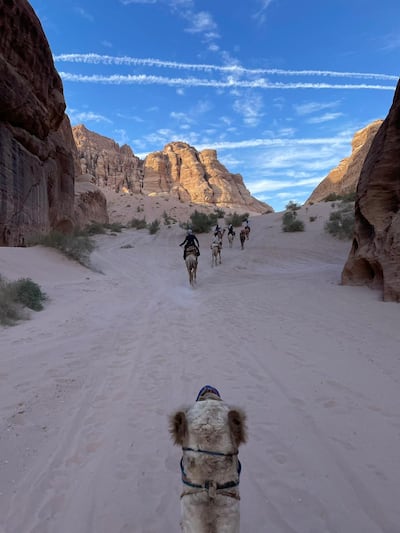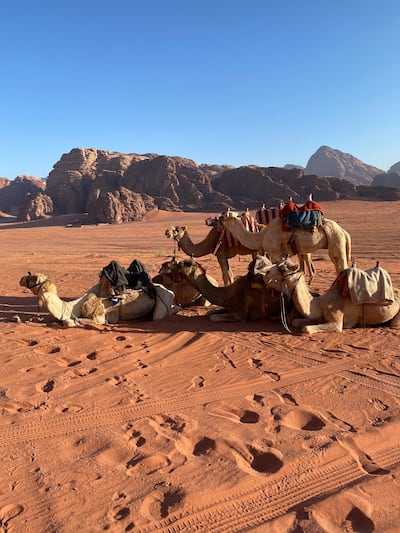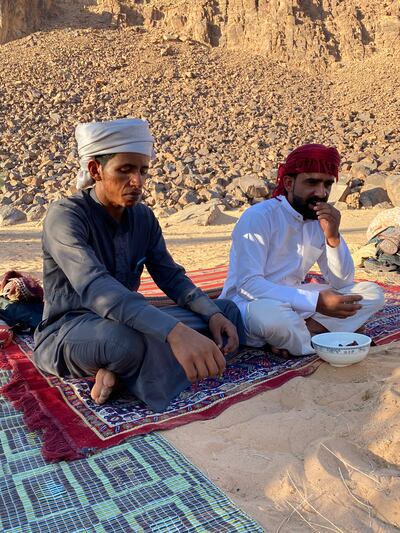A group from the UAE travelled to Jordan’s Wadi Rum, where they traversed 100km across the desert on camelback, an expedition they accomplished in three days.
The journey, which began on October 19, was organised by the Arabian Desert Camel Riding Centre. The group of six, most of whom are regular riders at the centre. They were led by Ayesh Al Anzi, a local Bedouin familiar with the terrain, as well as Jana Schmiedel, who has years of experience navigating deserts on camelback.
The trip was a test of endurance, says one of the participants Tariq Al Salman. The group has ample experience riding in the dune-filled expanses of the UAE, but Wadi Rum, with its Mars-like terrain and distinctive camel riding culture, presented a new set of challenges.

“It was really amazing,” he says. “We were six people. Two Emiratis and four from Europe.”
Al Salman explains that the group were initially hesitant to take the challenge on amid the Israel-Gaza war, but adds: “We eventually decided to go.”
The group headed for the desert after arriving in Jordan. They ventured three hours from the airport, spending their first night in a camp, where they met their four-hoofed companions, developing a rapport with them before starting their journey.
It was then the group attempted their first challenge. In the UAE, camel saddles are usually fitted behind the hump and are guided by a single lead and a stick, a style that has probably been developed for racing purposes. In Jordan, however, saddles are fitted to the top of the hump.
“The camels are trained to be led with two reins,” Schmiedel says. “Here, we are only riding with one on the left side.
"The stick is not really used there for direction, rather it's really the reins. With the wooden saddle, you sit much higher on the camel, on top of the hump but also much closer to the camel’s head.”
Another distinction is the sounds used to communicate with the camels, Schmiedel notes.

“The camels are trained to different sounds,” she says. “There were lots of little things we had to learn, but in general, I think we all adjusted very quickly.
“We had all done overnight trips before. One lady actually joined us from Germany. She hadn’t been riding with ADCRC but she has owned camels for 32 years, so she’s quite an expert.”
Schmeidel travelled to Jordan in February to prepare for the trip, meeting Al Anzi and charting out the route the group would take. She is no stranger to the country, having visited annually for a decade as part of several charity initiatives, and was excited for her peers at the centre to discover the country’s unique landscape.
“It would be amazing if the Wadi Rum trip could be an annual event,” she says. “There are different areas we could explore.”
While the trip was intended, in part, to put the group’s camel riding skills to the test, it was also a way for them to interact and learn about the desert and Bedouin culture outside of the UAE.

“We did 35km every day,” Al Salman says. “We went all the way into the wadi and then turned around behind the mountains and came back. We did a full loop. We saw different scenery.
"We started with red sand, then yellow and white sands, different shapes of mountains. There was no mobile signal either. Three days with no coverage, no data, no voice, nothing. I was refreshed and relieved from stress.
"There were basically no people there. We only saw people who herd their own camels. One person gave us fresh camel milk.”
The group were also given a taste of Bedouin foods. While zaatar and bread, fruits and vegetables were staples for breakfast and lunch, Al Anzi would prepare Jordanian dishes for dinner.
“He’d cook us things that are native to Jordan,” Al Salman says. “Like rice, with bread and vegetable gravy. For the first night, we had some chicken, but we didn’t have any meat afterwards. It wouldn’t have lasted.”
The journey across Wadi Rum marks the first of a series of expeditions riders from the centre are planning for the rest of the season. The trip was also the first time the centre ventured beyond the Gulf’s deserts.
“Teaching people how to ride should have a bit of a purpose,” Linda Krockenberger, managing partner at the centre, says. “For me, part of this purpose is the exploration, slow travel and discovering the desert beyond the UAE. I wanted people to train how to ride, then apply those skills during travel.”
Though Krockenberger herself did not take part in the expedition, she helped organise it along with Schmiedel. Having local participation in the trip was an essential aspect, Krockenberger says. This also has been the case for past, as well as upcoming trips around the UAE, Oman and Saudi Arabia.

“We want local families and camel owners to guide and lead this experience,” she says. “We don’t want to just export ourselves into something.”
Located near Al Marmoom Heritage Village in Dubai, the centre opened its doors in 2021 offering camel riding, training and race preparation. It has actively taken part in and organised local races, including the C1 Championship, part of the Female Camel Racing Series.
“The school has grown not just in riders but also in programmes,” Krockenberger says. “We have trained a lot more people, and there is more competency. That allows us to organise more trips.
"The [Wadi Rum] trip is one of them. Last winter we ran multiple desert crossings in the UAE. We rode from Dubai to Sharjah, from Dubai to Abu Dhabi.
"The rides are entirely self-supported so we don’t have vehicles following us.
“I feel like we've managed to create a platform for different itineraries and needs. From slow travel to the other extreme, into racing.
“I think it's important to really tell people, you don't have to be an extreme athlete to do this. Camel riding has a low entry barrier. It’s all about just getting started, and taking it as you grow.”







